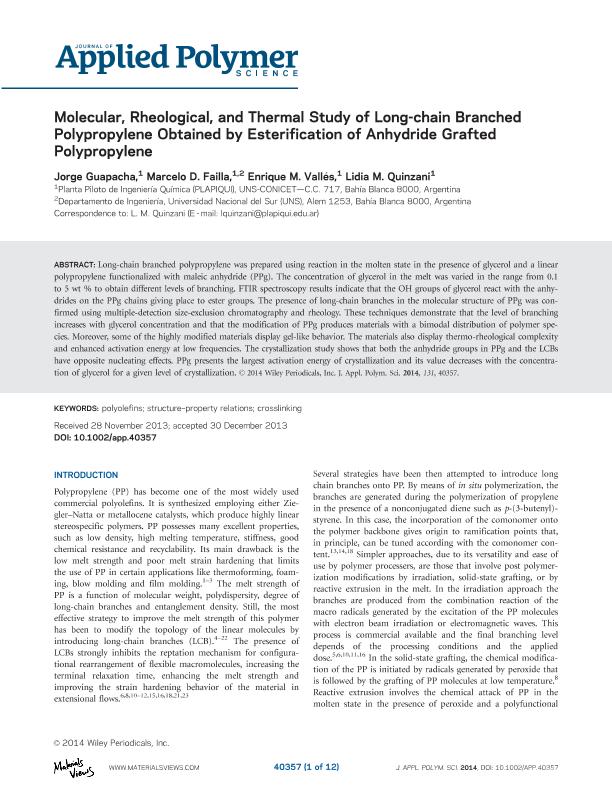Mostrar el registro sencillo del ítem
dc.contributor.author
Guapacha Martínez, Jorge Ariel

dc.contributor.author
Failla, Marcelo Daniel

dc.contributor.author
Valles, Enrique Marcelo

dc.contributor.author
Quinzani, Lidia Maria

dc.date.available
2017-03-03T20:25:44Z
dc.date.issued
2014-01
dc.identifier.citation
Guapacha Martínez, Jorge Ariel; Failla, Marcelo Daniel; Valles, Enrique Marcelo; Quinzani, Lidia Maria; Molecular, rheological, and thermal study of long-chain branched polypropylene obtained by esterification of anhydride grafted polypropylene; Wiley; Journal Of Applied Polymer Science; 131; 12; 1-2014; 1-2
dc.identifier.issn
0021-8995
dc.identifier.uri
http://hdl.handle.net/11336/13517
dc.description.abstract
Long-chain branched polypropylene was prepared using reaction in the molten state in the presence of glycerol and a linear polypropylene functionalized with maleic anhydride (PPg). The concentration of glycerol in the melt was varied in the range from 0.1 to 5 wt % to obtain different levels of branching. FTIR spectroscopy results indicate that the OH groups of glycerol react with the anhydrides on the PPg chains giving place to ester groups. The presence of long-chain branches in the molecular structure of PPg was confirmed using multiple-detection size-exclusion chromatography and rheology. These techniques demonstrate that the level of branching increases with glycerol concentration and that the modification of PPg produces materials with a bimodal distribution of polymer species. Moreover, some of the highly modified materials display gel-like behavior. The materials also display thermo-rheological complexity and enhanced activation energy at low frequencies. The crystallization study shows that both the anhydride groups in PPg and the LCBs have opposite nucleating effects. PPg presents the largest activation energy of crystallization and its value decreases with the concentration of glycerol for a given level of crystallization.
dc.format
application/pdf
dc.language.iso
eng
dc.publisher
Wiley

dc.rights
info:eu-repo/semantics/openAccess
dc.rights.uri
https://creativecommons.org/licenses/by-nc-sa/2.5/ar/
dc.subject
Polyolefins
dc.subject
Structure-Propery Relations
dc.subject
Crosslinking
dc.subject.classification
Ingeniería de los Materiales

dc.subject.classification
Ingeniería de los Materiales

dc.subject.classification
INGENIERÍAS Y TECNOLOGÍAS

dc.title
Molecular, rheological, and thermal study of long-chain branched polypropylene obtained by esterification of anhydride grafted polypropylene
dc.type
info:eu-repo/semantics/article
dc.type
info:ar-repo/semantics/artículo
dc.type
info:eu-repo/semantics/publishedVersion
dc.date.updated
2017-03-03T19:00:39Z
dc.identifier.eissn
1097-4628
dc.journal.volume
131
dc.journal.number
12
dc.journal.pagination
1-2
dc.journal.pais
Estados Unidos

dc.journal.ciudad
Hoboken
dc.description.fil
Fil: Guapacha Martínez, Jorge Ariel. Consejo Nacional de Investigaciones Científicas y Técnicas. Centro Científico Tecnológico Bahía Blanca. Planta Piloto de Ingeniería Química (i); Argentina
dc.description.fil
Fil: Failla, Marcelo Daniel. Consejo Nacional de Investigaciones Científicas y Técnicas. Centro Científico Tecnológico Bahía Blanca. Planta Piloto de Ingeniería Química (i); Argentina. Universidad Nacional del Sur. Departamento de Ingeniería; Argentina
dc.description.fil
Fil: Valles, Enrique Marcelo. Consejo Nacional de Investigaciones Científicas y Técnicas. Centro Científico Tecnológico Bahía Blanca. Planta Piloto de Ingeniería Química (i); Argentina
dc.description.fil
Fil: Quinzani, Lidia Maria. Consejo Nacional de Investigaciones Científicas y Técnicas. Centro Científico Tecnológico Bahía Blanca. Planta Piloto de Ingeniería Química (i); Argentina
dc.journal.title
Journal Of Applied Polymer Science

dc.relation.alternativeid
info:eu-repo/semantics/altIdentifier/url/http://onlinelibrary.wiley.com/doi/10.1002/app.40357/abstract
dc.relation.alternativeid
info:eu-repo/semantics/altIdentifier/doi/http://dx.doi.org/10.1002/app.40357
Archivos asociados
